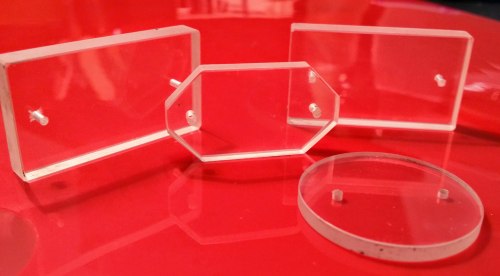Overview of Potassium Chloride (KCl)
Potassium Chloride (KCl) is a crystalline compound that serves multiple purposes in various industries. It’s wide transmission band makes it suitable for optical applications spanning UV, visible, mid-wave, and far-IR regions. The comprehensive data sheet offers a detailed view into its properties.
Key Properties of KCl
The optical and physical properties of KCl make it a viable option for several applications. Here are some key properties:
- Transmission range: 0.21 to 20µm
- Refractive Index: 1.45644 @ 10µm
- Density: 1.99 g/cm3
- Melting Point: 776°C
- Hardness: Knoop 7.2 <110>, 9.3 <100> with 200g indenter
Application of KCl in Optical Components
KCl is used in a variety of optical components, including windows and ground blanks. Knight Optical, a prominent optical component manufacturer, supplies KCl windows with typical specifications like:
- Diameter: < 5mm to 80mm
- Form error (@633nm): < 0.25 waves
- Centration/parallelism: < 1 arc minute
- Scratch/dig: < 40/20
- Typical coatings: BBAR @ 1-20µm, DLC @ 1-20µm
KCl Window for FTIR Applications
KCl windows have a significant presence in FTIR applications due to their low solubility and reflection losses. Companies like Buck Scientific have been supplying high-quality FTIR windows made of KCl since 1970.
Key Features of KCl Window
- KCl windows are less soluble than NaCl, with lower reflection losses
- They have an extended transmission range
- KCl is hygroscopic, meaning it absorbs moisture from the atmosphere
- The working wavelength range for KCl is 55,600 – 439 cm-1
KCl Window for CO2 Lasers
KCl windows are particularly useful for sputter barrier windows in CO2 lasers due to their low refractive index and high threshold damage. They are known for their high infrared transmittance, with a transmittance greater than 90% when thickness is less than 10mm and in the range of 4000-500cm-1.
Detailed Specifications of KCl Window
- Orientation: <100>, <110>, <111>
- Orientation Tolerance: < 0.5°
- Parallelism: 5〞
- Perpendicularity: 3ˊ
- Surface Quality: 10-5 (Scratch/Dig)
- Wavefront Distortion: <λ/4@632 nm
- Surface Flatness: <λ/8 @632 nm
- Clear Aperture: >90%
- Chamfer: <0.1×45°
- Thickness/Diameter Tolerance: ±0.05 mm
- Crystal Structure: Cubic
- Symmetry Class: m3m
- Lattice Constants: 6.291 Å
- Density: 1.989 g/cm3
- Melting Point: 776°C
- Cleavability: (100), perfect
- Thermal Conductivity: /(W·m-1·K-1)@46°C6.53
- Specific Heat: (J·kg-1·K-1)690
- Thermal Expansion: (10-6·K-1@60°C)34.1 … 38.3
- Hardness (Knoop): 7.2@<110>, 9.3@<100>
- Vickers Microhardness (GPa): 0.15
- Young’s Modulus (GPa): 16.8@<110>, 38.2@<100>
- Shear Modulus (GPa): 6.3@<110>, 10.8@<100>
- Bulk Modulus (GPa): 17.36
- Rupture Modulus (GPa): 4.41×10-3
- Elastic Coefficient (GPa): C11=40.2, C12=6.7, C44=6.29
- Transmission Range: 0.21 … 30µm
- Refractive Index: [email protected]µm, [email protected]µm
- Reflective Loss: 6.8%@10.0µm
- Reststrahlen: 63.1µm
- Poisson Ratio: 0.134 λ(μm)nλ(μm)nλ(μm)n0.21.71751.4703111.45270.51.496861.4683121.446311.479671.465912.51.44621.475181.4632151.432531.473591.4601201.394741.472101.4566301.2626
So, to answer the question of what is a KCl window – it is an optical window made from Potassium Chloride, highly prized for its excellent optical properties and applications in various industries. From CO2 lasers to FTIR spectrophotometers, KCl windows play a pivotal role in modern technology.






